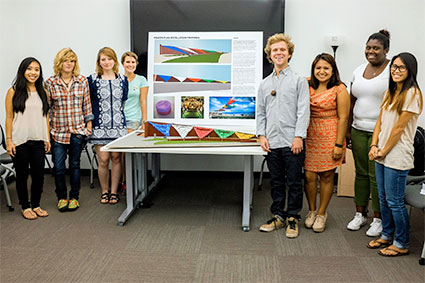 Students from Visiting Professor of Sculpture Stacey Holloway's Intermediate Sculpture class presented their UAB DAAH Prayer Flag Project installation proposal, Tuesday, Sept. 16. Participating students are, from left: Lisa Nguyen, Kaitlyn Roberts, Kelsey Parrish, Katie Walden, Timothy Harstvedt, Alma Allende, Jayla Perry, and Ashley Cook.Inspired by and in collaboration with Birmingham artist Carrie Bloomston’s Happy Flag Project, the University of Alabama at Birmingham Department of Art and Art History is creating a community prayer flag installation to celebrate the Dalai Lama’s visit to Birmingham.
Students from Visiting Professor of Sculpture Stacey Holloway's Intermediate Sculpture class presented their UAB DAAH Prayer Flag Project installation proposal, Tuesday, Sept. 16. Participating students are, from left: Lisa Nguyen, Kaitlyn Roberts, Kelsey Parrish, Katie Walden, Timothy Harstvedt, Alma Allende, Jayla Perry, and Ashley Cook.Inspired by and in collaboration with Birmingham artist Carrie Bloomston’s Happy Flag Project, the University of Alabama at Birmingham Department of Art and Art History is creating a community prayer flag installation to celebrate the Dalai Lama’s visit to Birmingham.
The large-scale installation of more than 1,000 flags will be on exhibit Oct. 20-26 in the UAB College of Arts and Sciences’ Abroms-Engel Institute for the Visual Arts Sculpture Garden, 1221 10th Ave. South. An outdoor reception is planned for 5-6:30 p.m. Wednesday, Oct. 22. The event is free and open to the public.
Since July, the Department of Art and Art History has collaborated with participants across the UAB campus and throughout Birmingham in making prayer flags. DAAH faculty led Woodlawn High School students in making flags during the Woodlawn Summer Bridge Program, and the UAB departments of Anthropology, Biology, Government, Sociology and Philosophy, as well as the School of Public Health, have contributed to the project. Assistant Professor of Art Doug Baulos led prayer flag workshops across campus, including with the Alpha Gamma Delta sorority, UAB Art Club and the UAB Honors College, and UAB art students enrolled in painting, drawing, design, photography and art classes have made hundreds of flags throughout the semester.
Visiting Assistant Professor of Sculpture Stacey Holloway’s Intermediate Sculpture class designed the installation and presented their installation proposal to a committee of UAB officials in September. The interactive installation will span more than 100 feet across the AEIVA Sculpture Garden and include seating areas for meditation.
| “Traditionally, prayer flags are used to promote peace, compassion, strength and wisdom. The flags do not carry prayers to gods, which is a common misconception; rather, the Tibetans believe the prayers and mantras will be blown by the wind to spread the good will and compassion into all pervading space. Therefore, prayer flags are thought to bring benefit to all.” |
“The project has a positive impact on our students’ academic learning by seeking to achieve real objectives for the community and deeper understanding of professional skills, including working in team environments,” said DAAH Chair Lauren Lake. “Their experience enhances understanding, which leads to more effective action.”
While traditional Tibetan Buddhist motifs are featured on many flags, others include personal messages, commemorations, quotes, or other ecumenical and/or nonreligious messages. Students have been encouraged to express themselves, their hopes, their dreams and other positive ideas onto the flags.
“Traditionally, prayer flags are used to promote peace, compassion, strength and wisdom,” Bloomston said. “The flags do not carry prayers to gods, which is a common misconception; rather, the Tibetans believe the prayers and mantras will be blown by the wind to spread the good will and compassion into all pervading space. Therefore, prayer flags are thought to bring benefit to all.”
Prayer flags positively change the environment in which they are placed, and the same should be said of art, says Jared Ragland, DAAH visual media and outreach coordinator.
“Our goal has been to create a project that celebrates the Dalai Lama’s visit and provides an opportunity for creative expression and interdisciplinary collaboration across UAB and around the city of Birmingham,” Ragland said. “This installation will, like the recent ‘Magic Chromacity’ project, highlight UAB’s Cultural Corridor through the presentation of a public artwork that explores multicultural identities and vernacular sources in a contemporary art context.”
To keep up with the project and see photographs, visit the Department of Art and Art History on Facebook. Use and follow #UABWhisperAway on social media for all project updates. For more information, contact Ragland at raglandj@uab.edu.